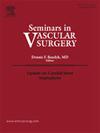Diabetic foot infections: Questions for an infectious disease consultant
IF 2.4
3区 医学
Q1 PERIPHERAL VASCULAR DISEASE
引用次数: 0
Abstract
Diabetic foot infection can lead to limb amputation in approximately 17% of affected patients. Given the complex pathophysiology associated with diabetic foot infection, the goal of limb preservation is best achieved with a multidisciplinary approach and a team of providers including infectious disease consultants. However, these infections often affect populations living in nonmetropolitan areas, where access to an infectious disease physician may be limited. It may fall on the surgeons and primary care providers to not only diagnose infections early, including osteomyelitis, but also facilitate prompt, appropriate antibiotic management. The decision to treat with antibiotics alone versus surgery, choice of antibiotic, route of administration, and duration of treatment are complicated concepts that require a patient-specific approach. In addition, use of oral antibiotics and long-acting lipoglycopeptides has gained prominence and offers an alternate solution to the tedious, resource-intense process of outpatient intravenous antibiotic treatment. The goal of this article is to outline and address diagnostic and management questions that would be posed to an infectious disease consultant. The responses would include a literature review of current management concepts and highlights from the 2023 Infectious Disease Society of America and International Working Group on the Diabetic Foot guidelines.
糖尿病足部感染:传染病顾问的问题
糖尿病足感染可导致约17%的患者截肢。考虑到与糖尿病足感染相关的复杂病理生理,肢体保存的目标最好通过多学科方法和包括传染病顾问在内的提供者团队来实现。然而,这些感染通常影响生活在非大都市地区的人群,在那里获得传染病医生的机会可能有限。外科医生和初级保健提供者不仅要及早诊断感染,包括骨髓炎,而且要促进及时、适当的抗生素治疗。决定单独使用抗生素还是手术,抗生素的选择,给药途径和治疗时间是复杂的概念,需要针对具体患者的方法。此外,口服抗生素和长效脂糖肽类药物的使用日益突出,为门诊静脉注射抗生素治疗的繁琐、资源紧张的过程提供了另一种解决方案。这篇文章的目的是概述和解决诊断和管理问题,将提出一个传染病顾问。回应将包括对当前管理概念的文献综述,以及2023年美国传染病学会和国际糖尿病足指南工作组的重点内容。
本文章由计算机程序翻译,如有差异,请以英文原文为准。
求助全文
约1分钟内获得全文
求助全文
来源期刊
CiteScore
3.50
自引率
4.00%
发文量
54
审稿时长
50 days
期刊介绍:
Each issue of Seminars in Vascular Surgery examines the latest thinking on a particular clinical problem and features new diagnostic and operative techniques. The journal allows practitioners to expand their capabilities and to keep pace with the most rapidly evolving areas of surgery.

 求助内容:
求助内容: 应助结果提醒方式:
应助结果提醒方式:


